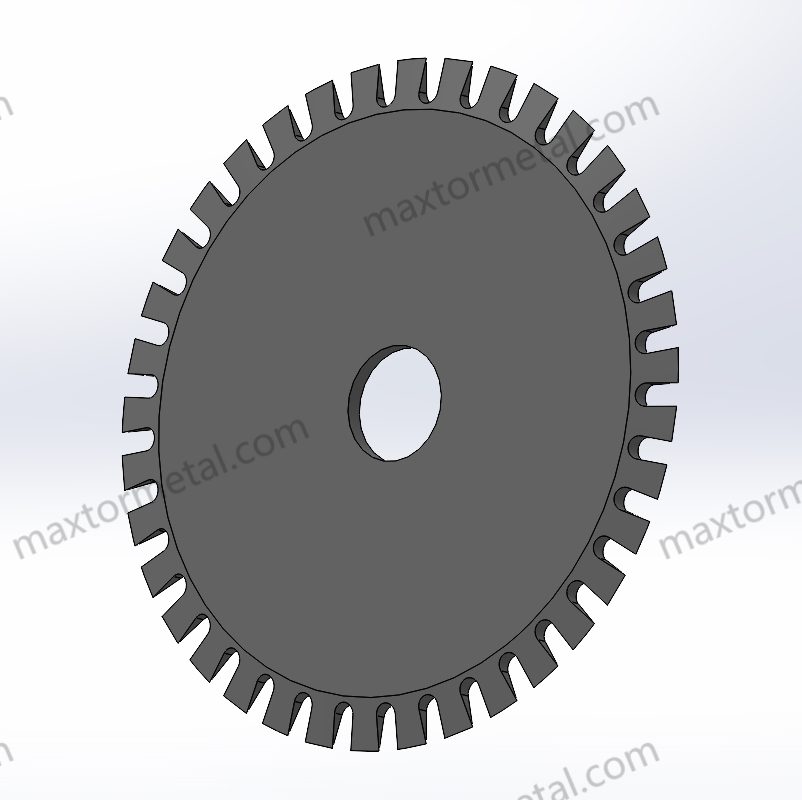
Tienes una elección importante al elegir Cuchillas perforadoras para embalajeUn estudio de 2022 mostró que 68% de problemas en la línea de envasado Los problemas se deben a la elección de la cuchilla incorrecta. Si elige la cuchilla adecuada para su material y necesidades, trabajará más rápido y obtendrá mejores resultados. La cuchilla que elija afecta la velocidad, el desperdicio y el gasto en reparaciones. La siguiente tabla muestra cómo las cuchillas de perforación avanzadas le ayudan a obtener mejores resultados:
| Beneficio | Descripción del impacto |
|---|---|
| Eficiencia de producción | Las cuchillas de perforación avanzadas pueden hacer que su línea 12-15% funcione mejor cada año. |
| Velocidad de rendimiento | El uso de las mejores cuchillas puede hacer que las líneas funcionen hasta 20% más rápido. |
| Reducción de residuos | Estas cuchillas reducen los residuos de embalaje en un 20-30%, lo que ahorra dinero y ayuda al planeta. |
| Durabilidad de la cuchilla | Los recubrimientos como TiN o DLC hacen que las hojas duren más, por lo que usted se detiene menos y compra menos hojas. |
| Calidad del producto | Una buena perforación proporciona cortes limpios y prolijos necesarios para hojas desprendibles, etiquetas y sellos. |
| Personalización | Cuchillas especiales hechas para sus necesidades hacen que su línea sea más rápida y sus productos mejores. |
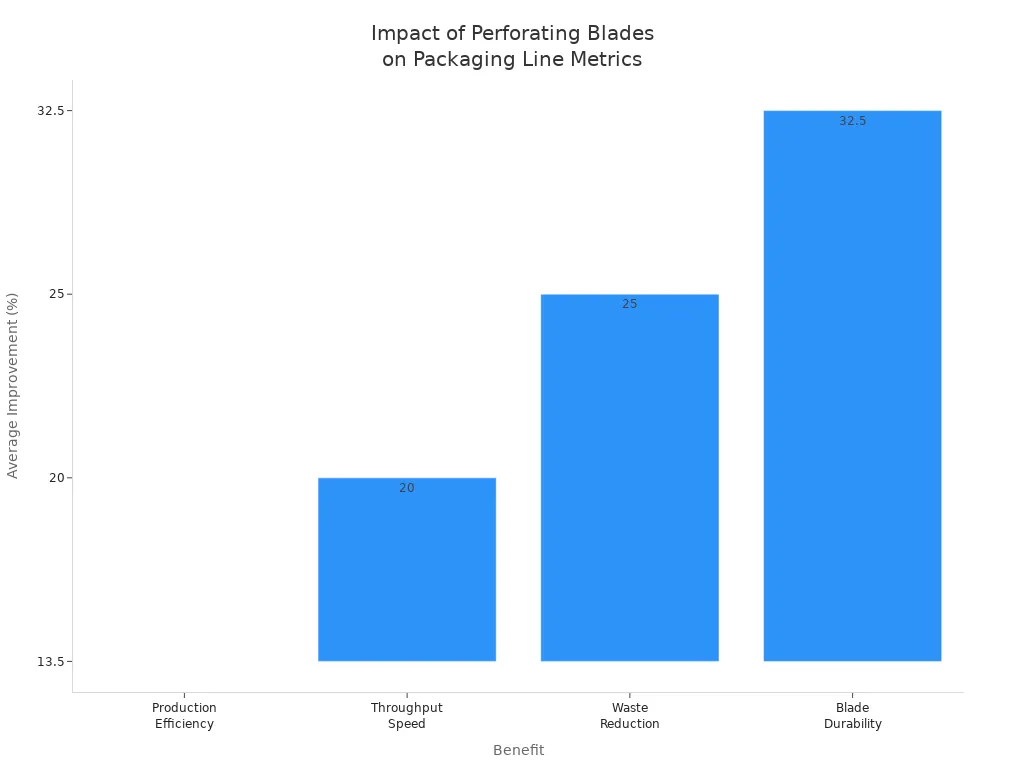
Puede evitar errores y retrasos costosos hablando con expertos y trabajando con proveedores confiables como Maxtor Metal. Esta descripción general de los cuchillos perforadores le ayudará a ver lo importante que es tomar decisiones inteligentes.
Puntos clave
- Elija cuchillas de perforación que se adapten a su material de embalaje. Esto le ayudará a obtener cortes limpios y reducir el desperdicio. – Elija materiales de cuchillas como carburo de tungsteno o acero de alta velocidad. Estos duran más y agilizan la producción. – Pruebe cuchillas de muestra en su embalaje real. Esto le ayudará a encontrar la mejor calidad de corte y resistencia al estallido. – Trabaje con proveedores y expertos de confianza para obtener asesoramiento y cuchillas personalizadas. También pueden brindarle soporte cuando lo necesite. – Cuide sus cuchillas y revíselas con frecuencia. Esto mantiene su línea de embalaje funcionando correctamente y ahorra dinero.
Cuchillas perforadoras para embalaje: factores clave
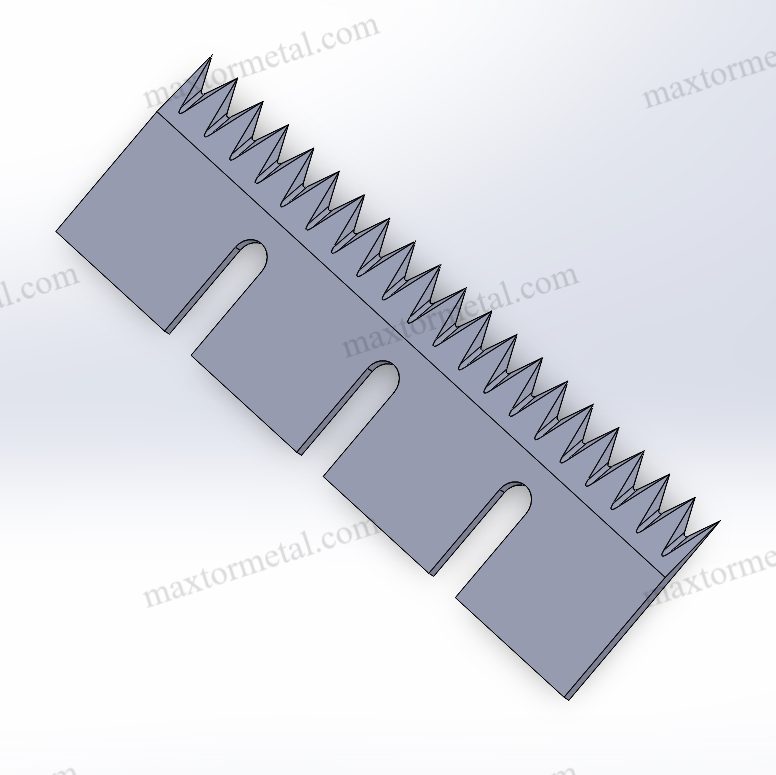
Compatibilidad de materiales
Al elegir cuchillas de perforación, piense en lo que va a cortar. Cada material de embalaje necesita un tipo de cuchilla específico. Usar una cuchilla incorrecta puede provocar bordes ásperos o líneas de corte incorrectas. Incluso puede dañar su producto. Existen muchos materiales de embalaje. Algunos de los más comunes son:
- Plásticos: Son ligeros y se doblan fácilmente. Se necesitan cuchillas que corten limpiamente sin derretir ni arrancar la película.
- Vidrio: El vidrio es resistente y no reacciona con los objetos. Debe usar cuchillas que no lo astillen ni lo agrieten.
- Metal: Metal necesita cuchillas que se mantengan afiladas y no se desgasten rápidamente.
- Materiales biodegradables: Estos necesitan cuchillas que no rasguen ni deshilachen los bordes.
- Laminados: Los laminados tienen capas. Se necesitan cuchillas que corten todas las capas y mantengan la línea recta.
También podría encontrar materiales especiales como goma, materiales pegajosos o plásticos resistentes a altas temperaturas. Para estos, necesita hojas con recubrimientos o formas especiales. Si adapta la hoja al material, obtendrá mejores cortes y menos problemas.
Consejo: Antes de elegir una cuchilla, compruebe siempre cómo reacciona el embalaje al calor o a los productos químicos. Esto ayuda a evitar daños o reacciones adversas.
Material y durabilidad de la hoja
Elegir el material adecuado para las cuchillas de perforación garantiza un buen funcionamiento. Maxtor Metal utiliza materiales resistentes como acero para herramientas, acero de alta velocidad (HSS), acero inoxidable y carburo de tungsteno. Cada uno tiene una resistencia diferente que contribuye a su durabilidad.
| Material de la Cuchilla | Características de durabilidad y vida útil | Aplicaciones típicas y notas |
|---|---|---|
| Herramienta de acero | Duro y resistente, pero no dura tanto; más barato; fácil de afilar; no tan fuerte como otros. | Se utiliza en embalajes, papel, plásticos; bueno si quieres ahorrar dinero y no necesitas que dure mucho tiempo. |
| Acero de alta velocidad (HSS) | Dura más y soporta el calor mejor que el acero para herramientas; bueno para cortes rápidos; fácil de afilar. | Se utiliza para papel y películas; una buena combinación de precio, resistencia y fácil cuidado. |
| Carburo de tungsteno | Más duro y más duradero; mantiene un filo afilado; soporta el calor; ideal para trabajos difíciles. | Ideal para embalajes pesados, caucho y materiales duros; cuesta más, pero ahorra dinero a largo plazo; puede romperse si se cae. |
| Acero inoxidable | Dura un tiempo medio, no se oxida, bueno para lugares donde necesitas mantener las cosas limpias. | Se utiliza para alimentos, medicamentos y envases limpios; fácil de lavar; duración media. |
Si busca hojas más duraderas y que requieran menos afilado, elija HSS o carburo de tungsteno. El acero inoxidable es ideal para envases de alimentos y productos médicos porque no se oxida. El acero para herramientas es la mejor opción si quiere ahorrar dinero y no necesita que dure mucho. Elegir el material adecuado para el cuchillo implica menos paradas y una línea más suave.
Velocidad y volumen de producción
La velocidad de trabajo depende de la cuchilla que utilice. Si su línea es rápida, necesita cuchillas que no se desgasten rápidamente. Las cuchillas de perforación rotativas son ideales para líneas rápidas y rollos largos. Estas cuchillas ejercen menos presión sobre el material y le ayudan a trabajar más rápido.
- Las hojas perforadas redondas son ideales para trabajos rápidos y grandes. Cortan bien y duran más.
- Las hojas rectas hacen cortes rectos. Úsalas cuando necesites líneas perfectas.
- Las hojas de carburo de tungsteno y HSS son ideales para trabajos grandes. Resisten el calor y el desgaste, lo que reduce las paradas.
Si elige la cuchilla adecuada para su trabajo, obtendrá mejores resultados y menos paradas. Además, ahorrará dinero al generar menos desperdicios y mover los productos con mayor rapidez.
Patrón de perforación y resistencia
El patrón y la resistencia al estallido de las cuchillas de perforación modifican el funcionamiento de su producto. La resistencia al estallido se refiere a la fuerza necesaria para rasgar a lo largo de la línea. Si desea envases de fácil apertura, necesita una resistencia al estallido menor. Si desea sellos resistentes, necesita una resistencia al estallido mayor.
Puedes cambiar el patrón usando diferentes formas de dientes, proporciones de atadura a corte y espaciado. Por ejemplo:
- Un patrón de dientes finos proporciona un desgarro limpio y una menor resistencia al estallido.
- Un patrón de dientes anchos hace que el paquete sea más fuerte y lo mantiene cerrado hasta que sea necesario.
- La relación entre ataduras y cortes indica cuánto material queda entre cortes. Cuantos más ataduras haya, más resistentes serán los paquetes.
Si prueba diferentes patrones, encontrará la mejor combinación de fácil apertura y protección. Maxtor Metal puede fabricar hojas personalizadas para ayudarle a obtener la resistencia al impacto y la calidad de corte adecuadas.
Nota: Pruebe siempre sus cuchillas perforadoras en un embalaje real. Esto le ayudará a comprobar la resistencia al estallido y a asegurarse de que su producto sea lo suficientemente bueno.
Tipos de cuchillas perforadoras
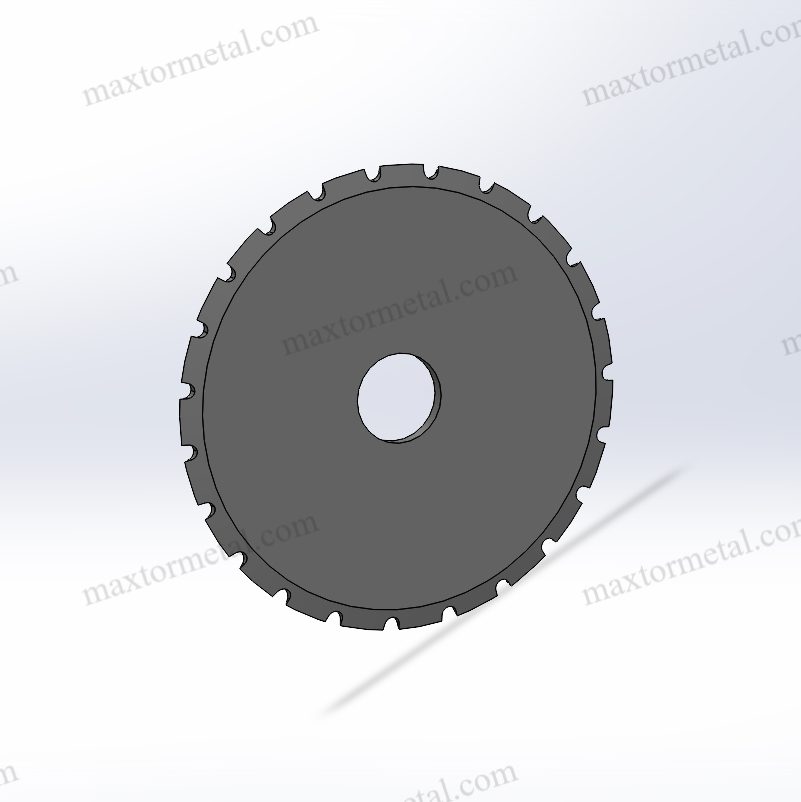
Cuchillas rectas y giratorias
Materiales adecuados
Puede utilizar cuchillas rectas y rotativas para papel, películas plásticas, laminados y metales ligeros. Estas cuchillas son ideales para hojas planas y rollos.
Aplicaciones Típicas
Las cuchillas rectas se utilizan para envoltorios de alimentos, envases flexibles, tiras desprendibles y etiquetas. Las cuchillas rotativas son ideales para líneas de envasado rápidas y trabajos que requieren un corte continuo.
Ventajas y desventajas clave
| Tipo de cuchilla | Ventajas | Desventajas |
|---|---|---|
| Cuchillas Rectas | Realizar cortes limpios, rectos y precisos. | Cortar únicamente en líneas rectas |
| Cuchillas giratorias | Corta rápido y dura mucho tiempo. | A veces se necesitan máquinas especiales |
Las cuchillas rectas te ayudan a crear líneas limpias y a controlar la facilidad de corte. Las cuchillas rotativas son ideales para trabajos grandes y mantienen la línea en movimiento rápido.
Características estructurales
Las cuchillas rectas tienen un filo recto para realizar cortes rectos. Las cuchillas rotativas son redondas y giran sobre un eje para un corte continuo.
Consejos de selección
- Utilice hojas rectas para realizar cortes simples y rectos en materiales planos.
- Elija cuchillas rotativas para un trabajo rápido y sin interrupciones.
- Pruebe muestras de las hojas para comprobar lo fácil que se rompen y lo limpio que es el corte.
- Pregúntele a Maxtor Metal para obtener ayuda con materiales y revestimientos de cuchillas.
Ejemplo de caso de la industria
Una empresa de snacks empezó a usar cuchillas rotativas recubiertas de titanio. Cambiaron las cuchillas. 35% menos y 20% más productosOtra fábrica utilizó cuchillas rotativas de carburo de tungsteno y ahorró entre $15.000 y 15.000 T/h al año.
Cuchillas dentadas y circulares
Materiales adecuados
Las cuchillas dentadas y circulares trabajan con papel, películas, láminas, textiles y materiales no tejidos.
Aplicaciones Típicas
Estas cuchillas se utilizan para etiquetas perforadas, tickets desprendibles, películas de embalaje y rollos textiles.
Ventajas y desventajas clave
| Tipo de cuchilla | Ventajas | Desventajas |
|---|---|---|
| Cuchillas Dentadas | Muchos patrones; los dientes pueden cambiar. | Puede dejar bordes más ásperos |
| Cuchillas circulares | Trabaja rápido y se puede personalizar. | Debe estar configurado correctamente |
Las cuchillas dentadas permiten controlar la facilidad de desmenuzar. Las cuchillas circulares son ideales para trabajos de rollo a rollo y para trabajos rápidos.
Características estructurales
Las hojas dentadas tienen bordes dentados para diferentes patrones. Las hojas circulares son redondas y pueden tener dientes o ser lisas.
Consejos de selección
- Elige el tamaño de diente y el espacio adecuados para el desgarro que deseas.
- Utilice hojas dentadas circulares para una perforación continua.
- Pruebe muestras para asegurarse de que cumplan con las reglas de envasado.
- Trabaja para formas de cuchillas especiales.
Ejemplo de caso de la industria
Una fábrica de etiquetas utilizó cuchillas de microdientes y tuvo un tiempo de inactividad de 28% menor. Las fábricas textiles utilizan cuchillas circulares para un mejor desgarro y menor desperdicio.
Opciones personalizadas y especiales
Materiales adecuados
Se fabrican cuchillas personalizadas para películas especiales, laminados multicapa y otros materiales de embalaje complicados.
Aplicaciones Típicas
Las hojas personalizadas se utilizan en envases médicos, etiquetas de seguridad y diseños de desgarro especiales.
Ventajas y desventajas clave
| Característica | Ventajas | Desventajas |
|---|---|---|
| Cuchillas Personalizadas | Hecho para tus necesidades; soluciona trabajos difíciles | Cuesta más; tarda más en llegar |
Las cuchillas personalizadas le ayudan a combinar el desgarro y el aspecto con su producto.
Características estructurales
Las hojas personalizadas tienen formas especiales, patrones de dientes o revestimientos para trabajos únicos.
Consejos de selección
- Hable con Maxtor Metal para cuchilla personalizada muestras.
- Pruebe las hojas para asegurarse de que funcionen con su embalaje y reglas.
- Utilice cuchillas especiales para paquetes a prueba de manipulaciones o transpirables.
Ejemplo de caso de la industria
Una fábrica de cajas utilizó cuchillas de microdientes personalizadas y redujo el tiempo de inactividad de 14 a 5 horas. Las empresas de alimentos utilizan cuchillas especiales para sellos a prueba de manipulaciones y paquetes de fácil apertura.
Consejo: consulte la guía de cuchillas perforadoras para elegir la mejor cuchilla para su línea de envasado.
Cómo elegir el rendimiento adecuado para su aplicación
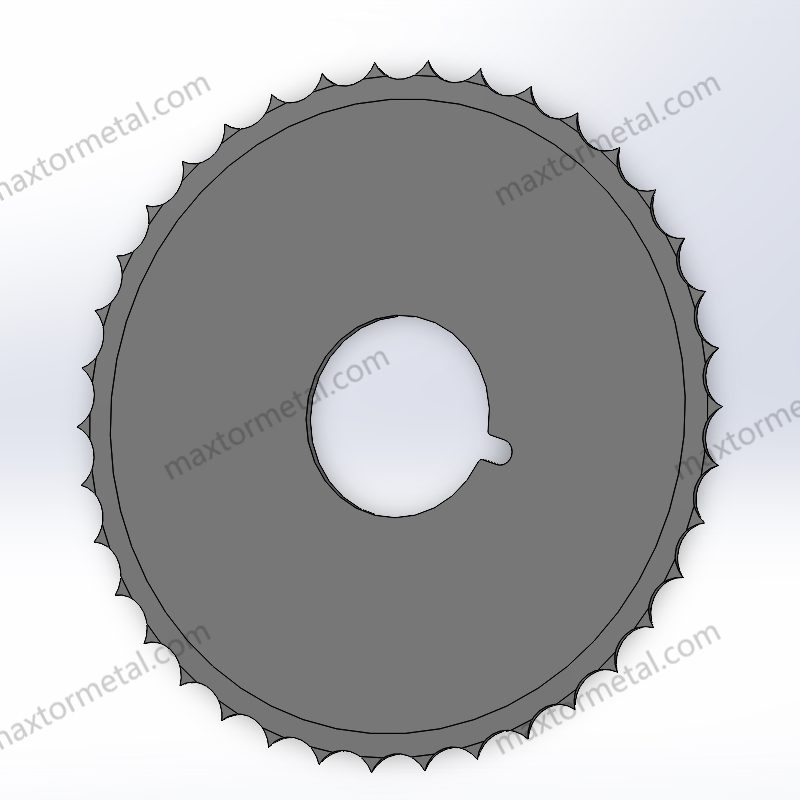
Evaluación de las necesidades de embalaje
Identificar los tipos de materiales de embalaje
Comience por verificar los materiales que utiliza para el embalaje. Cada material, como film, papel, caucho o metal, requiere una cuchilla especial. El film de plástico fino necesita una cuchilla que corte limpiamente y no derrita los bordes. El caucho o el metal gruesos necesitan una cuchilla resistente para trabajos difíciles. Al adaptar la cuchilla al material, se obtiene una mayor resistencia al estallido y al desgarro. Esto ayuda a evitar bordes ásperos y el desperdicio de producto.
Determinar los requisitos de protección del producto
Piense en cuánta protección necesita su producto. Algunos paquetes deben permanecer sellados hasta que el cliente los abra. Otros deben ser fáciles de abrir. Si desea sellos resistentes, elija cuchillas con alta resistencia al estallido. Para paquetes de fácil apertura, elija una resistencia al estallido menor. Debe encontrar el equilibrio entre protección y fácil apertura. La cuchilla adecuada mantiene su producto seguro y permite abrirlo fácilmente.
Considere el diseño y la funcionalidad del embalaje
Analice el diseño de su empaque y sus necesidades. ¿Necesita un corte recto o una forma especial? ¿Desea una tira perforada o un patrón personalizado? La cuchilla que elija debe ajustarse a su diseño. Las cuchillas rotativas crean líneas largas y rectas. Las cuchillas dentadas permiten crear diferentes patrones. Las cuchillas personalizadas le ayudan a obtener formas y características especiales. Un buen diseño ayuda a que su producto destaque y funcione mejor.
Evaluar los estándares regulatorios y de la industria
Debe cumplir con las normas de embalaje de su industria. Algunos productos, como alimentos y medicamentos, requieren cuchillas que no se oxiden ni dejen bordes afilados. Es posible que deba cumplir con las normas de resistencia al estallido o calidad de corte. Consulte siempre las normas antes de elegir una cuchilla. Cumplir con las normas garantiza la seguridad de sus productos y le ayuda a superar los controles de calidad.
Proceso de selección paso a paso
Los expertos del sector recomiendan seguir pasos claros para elegir la cuchilla de perforación adecuada. Puede seguir estos pasos para tomar decisiones inteligentes:
- Descubra qué material necesita cortar, como película, tela, goma o metal.
- Decide si quieres un corte liso, dentado o perforado.
- Mida el grosor y la densidad del material para saber qué debe hacer la cuchilla.
- Elija el tipo de cuchilla que se adapte a su trabajo, como cortadora, cortadora por aplastamiento, dentada o rotativa.
- Considere la velocidad de su línea y el tiempo de inactividad que puede gestionar. Elija un material y un diseño de cuchilla que equilibren velocidad y durabilidad.
- Asegúrese de que la cuchilla se ajuste a su máquina. Compruebe el tamaño, la forma y el filo.
- Pruebe hojas de muestra en su material real. Observe la calidad del corte y la resistencia al estallido.
- Cambie la configuración del cuchillo, como la presión, la velocidad y la alineación, después de probarlo.
- Pida asesoramiento y ayuda personalizada a proveedores de cuchillas o expertos.
- Observe el rendimiento de la cuchilla con el tiempo. Haga pequeños cambios para mantener cortes en buen estado y reducir las reparaciones.
Consejo: Pruebe siempre las hojas de muestra antes de la producción completa. Esto le ayudará a encontrar la mejor resistencia al estallido y la mejor calidad de corte para su embalaje.
Consultores expertos y proveedores
Contratar consultores técnicos para obtener orientación
Puede obtener ayuda de consultores técnicos expertos en cuchillas y embalajes. Le ayudarán a elegir la cuchilla adecuada para su material y diseño. Si tiene dificultades, pueden sugerirle soluciones personalizadas. Un buen asesoramiento le ahorra tiempo y dinero.
Aproveche la experiencia del proveedor
Los proveedores tienen amplia experiencia con cuchillas de perforación. Saben cómo adaptar el material y la forma de las cuchillas a sus necesidades. Puede consultarles sobre cómo elegir el material de cuchilla adecuado para su trabajo. Le ayudarán a evitar errores, como elegir el tamaño o el filo de la cuchilla incorrectos.
Explorar opciones de personalización y creación de prototipos
Si necesita una cuchilla especial, puede colaborar con proveedores para diseñar y probar opciones personalizadas. Estos proveedores ofrecen prototipos rápidos y comprobaciones técnicas. Puede solicitar lotes pequeños para realizar pruebas. Esto le permite probar nuevos diseños y encontrar la resistencia al estallido óptima para su paquete. Las cuchillas personalizadas le ayudan a resolver problemas complejos y a mejorar su producto.
Establecer un soporte continuo y garantía de calidad
Debe establecer una sólida relación con su proveedor. Este puede ayudarle con la capacitación, el mantenimiento de la máquina y el cuidado de las cuchillas. Los proveedores monitorean el rendimiento de las cuchillas y le enseñan a medir la eficiencia. El soporte continuo mantiene sus cuchillas funcionando bien Y su línea funcionará sin problemas. La garantía de calidad significa que siempre obtendrá cuchillas de calidad.
Nota: Trabajar con proveedores confiables le brinda soporte técnico, control de calidad y atención personalizada. Esto mantiene la eficiencia de su línea de envasado y la seguridad de sus productos.
Perforación de papel y materiales flexibles
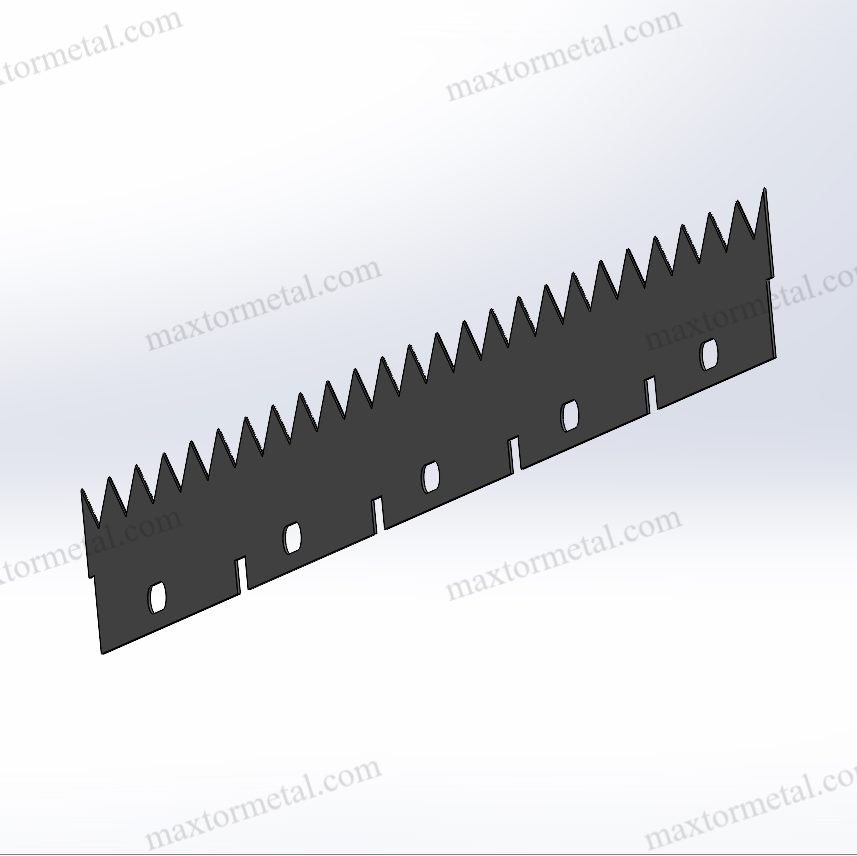
Consideraciones específicas del material
Al cortar papel o embalajes flexibles, es importante considerar el material. Cada material de embalaje se comporta de forma diferente al cortarlo o perforarlo. LDPE Es una opción común porque se dobla fácilmente, impide la entrada de agua y es económica. El LDPE se puede usar tanto para agujeros grandes como pequeños. Ayuda a mantener los alimentos frescos y es lo suficientemente resistente para su envío. Las películas de PET/PE requieren que se verifique su grosor y su resistencia al calor al cortarlas. Empresas como Amcor y Mondi han creado nuevas películas y papeles con agujeros para mantener los alimentos frescos y proteger el planeta.
| Tipo de material | Consideraciones y propiedades clave |
|---|---|
| LDPE | Se dobla fácilmente, evita la entrada de agua, es económico, ideal para agujeros grandes o pequeños, mantiene los alimentos frescos y es resistente para envíos. |
| Películas de PET/PE | ¿Necesita el láser adecuado? espesor, y capas para agujeros limpios y buen flujo de aire |
| Embalaje a base de papel | Los pequeños agujeros ayudan a que los alimentos duren más y son mejores para el medio ambiente. |
Optimización de la relación corte-espacio
La relación corte-espacio se refiere a la cantidad de cortes y espacios en la línea de agujeros. Este patrón determina la facilidad de apertura del paquete y su resistencia antes de abrirlo. Si desea un paquete que se abra fácilmente, utilice más cortes y espacios más pequeños. Si desea un sellado más resistente, utilice menos cortes y espacios más grandes. La forma y la separación entre los dientes de la cuchilla también influyen en la calidad de los agujeros. Debe elegir el patrón de cuchilla que mejor se adapte a su producto.
Consejo: Pruebe siempre la proporción de corte a espacio en sus paquetes antes de preparar una gran cantidad. Esto ayuda a evitar sellos débiles o paquetes demasiado difíciles de abrir.
Pruebas y ajustes
Siempre debe probar las cuchillas antes de hacer una gran cantidad. Comience haciendo algunos cortes de prueba para ver cómo funciona la cuchilla. Cambie la presión, la velocidad o la alineación de la cuchilla si es necesario. Revise los cortes constantemente y haga pequeños cambios para obtener mejores resultados. Si necesita ayuda, consulte con su proveedor de cuchillas.
- Realice algunos cortes de prueba para comprobar los agujeros.
- Cambie la presión, la velocidad o la posición de la cuchilla si es necesario.
- Observa los resultados y continúa mejorándolos.
- Si tienes preguntas, pide ayuda a expertos.
Probar y cambiar su proceso le ayudará a obtener excelentes resultados y a mantener su línea de envasado funcionando bien.
Errores comunes que se deben evitar

Ignorando las diferencias materiales
Algunas personas creen que todas las cuchillas funcionan igual. Pero cada material necesita su propia cuchilla. Si no presta atención, puede dañar las cuchillas y los productos. Estos son algunos errores que comete la gente:
- Utilizar la cuchilla incorrecta para el material, como una cuchilla de hormigón sobre metal.
- No pensar en si el material es duro o blando.
- Olvidarse de comprobar qué hay en el hormigón antes de cortarlo.
- Elegir el tamaño de grano de diamante o el aglomerante incorrecto para el trabajo.
- Utilizando gargantas anchas para materiales duros, lo que puede hacer que las hojas se calienten demasiado.
Si comete estos errores, las cuchillas se rompen y desgastan rápidamente. Se calientan demasiado y su vida útil es corta. Verá cortes ásperos, vibraciones y bordes irregulares. Estos problemas se traducen en más desperdicio, mayores costos y problemas de seguridad. Elija siempre la cuchilla adecuada para su material y revise las especificaciones antes de comenzar.
Consejo: Elija las hojas con la tamaño correcto del enlace y del esófago para su material. Esto le ayuda a obtener cortes suaves y prolonga la vida útil de las hojas.
Pasando por alto las demandas de producción
Si no piensa en sus necesidades de producción, las cuchillas no durarán. Necesita cambiar la configuración de la máquina y cuidar sus cuchillas. La siguiente tabla muestra lo que sucede si se olvidan las demandas de producción.:
| Causa | Efecto sobre las cuchillas y la línea | Acciones preventivas |
|---|---|---|
| No cambiar la configuración de la máquina | Las cuchillas se desgastan, los cortes son desiguales, la línea se detiene | Cambiar la velocidad, la presión y la profundidad de la cuchilla. |
| No realizar mantenimiento a la cuchilla | Las hojas se desafilan, se calientan demasiado y los cortes son ásperos. | Limpie, afile y lubrique las cuchillas con frecuencia |
| Mala instalación o alineación | Los cortes son torcidos, se producen atascos, las cuchillas resbalan. | Siga los pasos y verifique la alineación. |
| No vigilar el desgaste de la cuchilla | Mala calidad, más desperdicio, paradas de línea | Revise las cuchillas, reemplácelas o afílelas |
| Acumulación de material y óxido | Las cuchillas se dañan, se oxidan y no duran. | Limpie y seque las cuchillas, utilice aceites. |
| No realizar pruebas de funcionamiento | Errores de configuración, desperdicios, paradas de línea | Pruebe las cuchillas después de realizar cambios |
Mantienes tu línea funcionando bien cuando cambias la configuración y cuidas tus cuchillas.
Saltarse las pruebas y los controles de calidad
Prueba y comprobación de la calidad Le ayudará a detectar problemas a tiempo. Si omite estos pasos, obtendrá cortes graves y residuos. Debe utilizar herramientas como sistemas de visión, microscopios y comprobadores de filo para examinar las cuchillas. Los trabajadores pueden tomar decisiones rápidas y detener las máquinas si detectan problemas. Las revisiones periódicas y las inspecciones especiales, como los microscopios electrónicos de barrido, le ayudan a detectar pequeños problemas. También obtendrá mejores resultados utilizando métodos como Kaizen y Six Sigma.
Nota: Las pruebas y la verificación de calidad suelen mantener las cuchillas afiladas, los cortes limpios y los productos seguros. Ahorra dinero y reduce el tiempo de inactividad al incorporar las inspecciones a su trabajo.
Elegir la cuchilla de perforación adecuada le ayudará a realizar cortes más limpios. Tendrá menos desperdicio y sus productos lucirán mejor. Aquí tiene algunas recomendaciones:
- Elija un tipo de cuchilla y un material que se adapte a su embalaje.
- Pruebe muestras de las cuchillas y cambie la configuración de la máquina si es necesario.
- Obtenga ayuda de proveedores confiables para obtener asesoramiento y cuchillas personalizadas.
Los estudios demuestran que usar cuchillas personalizadas y trabajar con buenos proveedores agiliza el corte. Cambiará las cuchillas con menos frecuencia y los clientes estarán más satisfechos. Cuando se preocupa por la calidad y se colabora eficazmente, su línea de envasado funciona mejor y sus productos destacan.
Preguntas frecuentes
¿Qué materiales se pueden cortar con cuchillas perforadoras?
Las cuchillas pueden cortar muchos materiales. Sirven para papel, películas de plástico, laminados, textiles, caucho y metales ligeros. Estas cuchillas ofrecen cortes limpios y perforaciones resistentes para cada material.
¿Cómo elegir la cuchilla adecuada para su línea de envasado?
Elige una cuchilla que se adapte a tu material y a tu velocidad de trabajo. Prueba cuchillas de muestra antes de fabricar muchos productos. Puedes pedir ayuda a expertos. La forma y el material de cuchilla adecuados te darán mejores resultados.
¿Con qué frecuencia se deben reemplazar las cuchillas perforadoras?
Revise sus cuchillas con frecuencia para ver si están desafiladas o dañadas. Cámbielas si nota cortes ásperos o mayor desperdicio. Las cuchillas duran más, así que no necesita reemplazarlas con tanta frecuencia.
¿Se pueden pedir cuchillas de perforación personalizadas para necesidades de embalaje especiales?
Sí, Maxtor Metal le permite pedir cuchillas personalizadas. Estas cuchillas se fabrican para su embalaje, material o patrón de desgarro específico. Las cuchillas personalizadas le ayudan a solucionar problemas complejos y a mejorar sus productos.
Ver también
Comprensión de las cuchillas perforantes y sus aplicaciones prácticas



6 comentarios
Hola, creo que vi que visitaste mi blog, así que vine a devolver el favor. Estoy tratando de encontrar cosas para mejorar mi sitio web. Supongo que está bien usar algunas de tus ideas.
Gracias por su nueva visita.
Gracias por el auspicioso artículo. De hecho, fue un relato entretenido. Parece mucho más agradable de tu parte. Sin embargo, ¿cómo podemos comunicarnos?
Gracias por tu amable mensaje y reconocimiento. Me alegra que te haya gustado el artículo. Podemos contactarnos por correo electrónico, WhatsApp, formulario de contacto o comentarios.
Tu blog es una fuente constante de inspiración para mí. Tu pasión por el tema es palpable, y se nota que pones toda tu alma en cada publicación. ¡Sigue así!
¡Gracias por tu amable mensaje y reconocimiento!